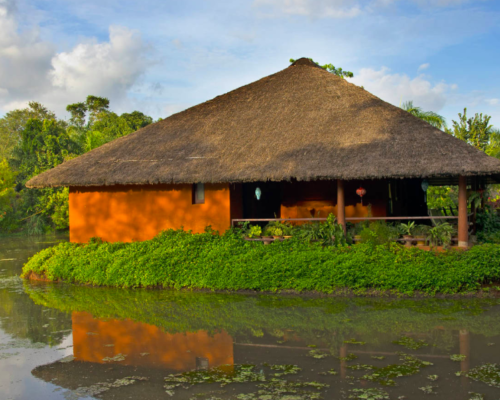The “Tadoba National Park,” also known as the “Tadoba Andhari Tiger Reserve,” is Maharashtra’s oldest and largest national park. It is one of India’s 47 planned tiger reserves. It is situated in Maharashtra’s Chandrapur district, approximately 150 km from Nagpur. In 1986, the Andhari Wildlife Sanctuary was established. In 1995, it was incorporated with the park to form the current Tadoba Andheri Tiger Reserve. The word “Tadoba” is formed from the name of God “Tadoba” or “Taru,” which is honoured by the local tribal people of this region, and “Andheri” is derived from the name of the Andhari river that flows in this area.

The Tadoba Andhari Tiger Reserve, which is located very close to our resort in Tadoba covers a total area of 625.4 square kilometres. Tadoba National Park, with an area of 116.55 square kilometres, and Andhari Wildlife Sanctuary, with an area of 508.85 square kilometres, were both established in 1955. The Tiger Reserve also comprises a protected forest of 32.51 square kilometres and additional regions of 14.93 square kilometres.
The Tadoba Tiger Reserve is home to a diverse range of vegetation and fauna. Teak, Ain, Bija, Dhauda, Hald, Salai, Semal, Tendu, Beheda, Hirda, Karaya gum, Mahua Madhuca, Arjun, Bamboo, Black Plum, and many other species of flora can be found in this park. Tigers, Indian leopards, Sloth bears, Gaur, Nilgai, Dhole, Striped Hyena, Small Indian Civet, Jungle Cats, Sambar, Spotted Deer, Barking Deer, Chital, Marsh Crocodile, Indian Python, Indian Cobra, Grey-headed Fish Eagle, Crested Serpent Eagle, Peacock, Jewel Beetles, Wolf Spiders, and others are among the animals present in this section.

The Tadoba National Park is separated into three forest ranges: the Tadoba north range, the Kolsa south range, and the Morhurli range, which lies between the first two. Maya tigress, a Tadoba mythology, guards her domain on the Tadoba range. Choti Tara, Tala, and Rudra all have domains in this area. Sonam tigress, together with Bajrang and Lara, own territory in the Moharli range. However, because Kolsa is a non-tourism zone, it’s difficult to say which tiger has a territory there. The ‘Tadoba Lake,’ ‘Kolsa Lake,’ and ‘Tadoba River’ are three lakes and one river in the park that are filled every monsoon.’ These lakes and rivers supply essential elements for the park’s survival.
Every season, from the 15th of October to the 30th of June, the park is available for visitors, except for Tuesdays when it is closed for the entire day. The vegetation of the Tadoba forest is of the Southern tropical dry deciduous type and covers 626 square kilometres. The forest is dominated by teak trees, and there are a few lakes, ensuring that the park has abundant water supplies because a large portion of this forest is in a mountainous area, various hillocks and terrains give sanctuary for wild animals. It boasts a dense forest, smooth meadows, deep valleys, and a beautiful atmosphere, all of which help to keep tigers in check.

The Jungle or Tiger Safari in an open-top Gypsy is the primary attraction of the Tadoba National Park. This forest is home to some of Central India’s best natural woodland bird species. The shy Sloth Bear and Wild dogs have a good possibility of being spotted. Tadoba Safari Stay jungle lodges are accessible and are primarily centered near two of the city’s most well-known entrance gates, Kolara Gate and Mohurli Gate.
Tadoba has a varied climate that is highly hot in the summer and somewhat cold in the winter. Aside from adequate attire, there are a few necessities to bring on Safari that might enhance the whole experience. The following is a list of items that can be brought along, Sun Screen, Sunglasses, Hat/Cap, preferably very light cotton Stole, buff, or scarf for protection from heat and dust during summer. Likewise, in winter, this list of items could be helpful, a windbreaker, a warm jacket, a sweater, a fleece blanket, gloves, and a warm cap, closed shoes or boots Camera with binoculars.



